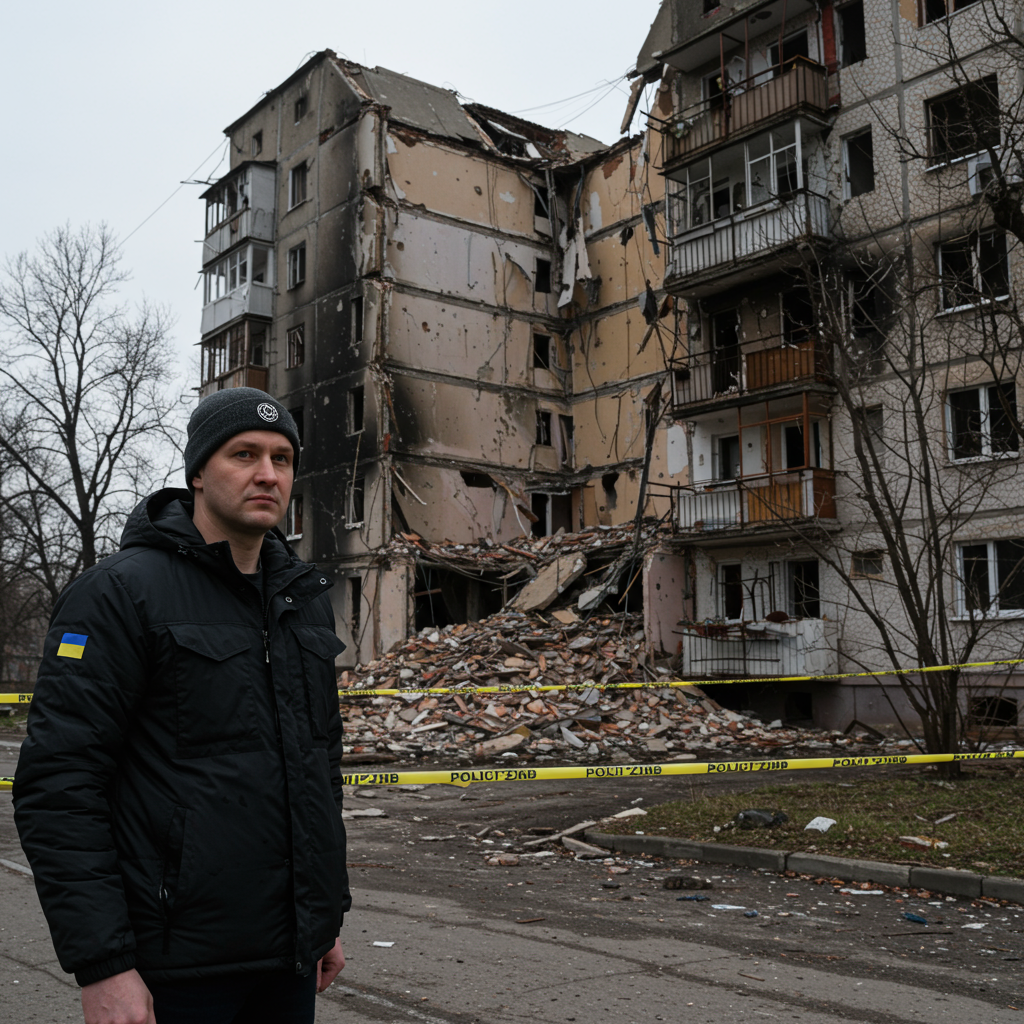The scene spoke volumes: yellow police tape cordoning off shattered lives, a mountain of rubble where an apartment block once stood whole. Evhen Povarenkov stared up at the remnants of his home in a Kyiv suburb – windows gone, a balcony hanging precariously, personal belongings scattered like fallen leaves.
This wasn’t just damage; it was the aftermath of a brutal missile strike. In the early hours of a Tuesday morning, a high-speed cruise missile slammed into his ordinary residential building in Kyiv’s Solomianskyi neighbourhood. The impact was catastrophic, hollowing out a significant section and destroying over 40 apartments.
The devastation at Evhen’s building was just one tragic point in a massive, hours-long barrage across the Ukrainian capital. Ukraine’s air force reported a “huge wave” of attacks, involving more than 440 drones and 32 missiles targeting the city for nine hours, from midnight until dawn. It was described as one of the worst attacks Kyiv had endured since the full-scale invasion began. Across the city, authorities later reported that at least 27 locations, including residential blocks, critical infrastructure, and educational facilities, were hit.
The Heavy Toll of the Attack
The human cost quickly mounted. By Wednesday afternoon, rescuers were still painstakingly searching through the debris of the Solomianskyi building. So far, 23 people had been found dead at this single site. The death toll across Kyiv from the night’s attacks had risen to at least 28, with more than 100 people injured in the city. The violence also extended beyond the capital, with casualties reported in the southern city of Odesa from related drone strikes. Tragically, among the victims confirmed killed in the Solomianskyi district was a 62-year-old US citizen.
Survivors recounted scenes of pure terror. Evhen Povarenkov, a 43-year-old warehouse worker, was in bed when the missile struck just metres away. “There was heat, fire, and smoke,” he recalled. He lost consciousness and awoke to the sound of his elderly mother screaming in the next room. Neighbours helped them escape their warped apartment door and navigate the chaos.
Pensioner Arcadiy Volenchuk, 60, described the immediate aftermath as “total chaos,” filled with the screams of people and the cries of children. Alla, 69, a teacher, spoke of navigating a treacherous path outside through burning cars with exploding fuel tanks, dodging falling debris including broken glass, concrete, and tiles.
Medical Response and Vulnerability
Evhen’s mother sustained severe injuries, including two broken collarbones, cuts to her eyes, and internal damage requiring surgery. She was one of the many wounded rushed to hospital across the city. Dr. Serhii Dubrov, director of the 12th Kyiv City Clinical Hospital, described the influx of patients arriving within hours of the strikes beginning at midnight. His hospital alone received 27 casualties with a range of severe injuries: lacerations from glass, damaged blood vessels, traumatic brain injuries, internal chest injuries, even a severed femoral artery and a critical open head injury.
The patients at Dr. Dubrov’s hospital ranged in age from 18 to 95, highlighting a particular danger of attacks on residential areas. The elderly and infirm, like 64-year-old disabled man Oleksandr Bondarchuk who lived near the Solomianskyi impact point, often cannot make it to underground shelters. Bondarchuk lay terrified in his bed throughout the barrage, later describing the devastation as “terrible.”
The Search Continues Amidst Political Context
The difficult work of search and rescue continued days after the attack. Emergency workers faced the grim task of sifting through the rubble, uncertain how many more victims they would find. Officials noted the challenges in identifying bodies returned in what was described as an “extremely mutilated state,” sometimes with body parts mixed between bags. Kyiv’s Mayor Vitali Klitschko also accused Russia of using cluster bomblets in the attack, designed to maximize casualties. Russia’s defence ministry, however, claimed their strikes targeted Ukraine’s military-industrial complexes and asserted all intended targets had been hit.
The timing of the massive strike coincided with Ukrainian President Volodymyr Zelensky’s trip to the G7 conference in Canada, where he sought increased international support, particularly air defenses. The scale of the attack underscored Ukraine’s desperate need. However, the trip ended in disappointment for Kyiv; a hoped-for meeting with US President Donald Trump didn’t occur as Trump left early due to the escalating Middle East crisis, and European leaders failed to issue a joint statement of support. Zelensky himself strongly condemned the attack as “pure terrorism,” accusing Russian President Vladimir Putin of carrying it out “solely because he can afford to continue this war.”
As President Zelensky returned home, residents and mourners gathered near the site of the Solomianskyi building, laying flowers in quiet tribute. Standing behind the police tape, unable to access his shattered apartment to retrieve belongings, Evhen Povarenkov could only watch as emergency workers 100 feet away uncovered yet more bodies from the debris. The search for the dead goes on.



